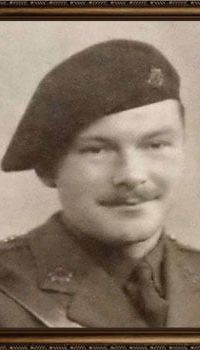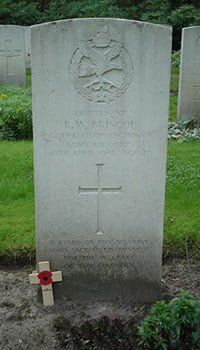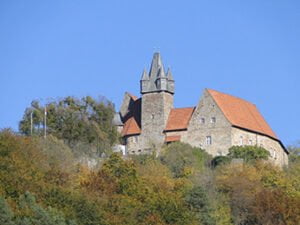Briscoe | Richard William
- First names
Richard William
- Age
27
- Date of birth
1918
- Date of death
10-04-1945
- Service number
299603
- Rank
Lieutenant
- Regiment
The Glider Pilot Regiment, A.A.C.
- Grave number
IV. A. 13.


Biography
Son of William and Jane Briscoe, St Helens, England
Husband of Emma Bartolo from Floriana, Malta G.C.
Husband of Lily Beatrice Smith
Husband of Mary Vivian Blackburn from Great Horkesley, Essex
Father of Paul Briscoe (27 Nov 1944 – 20 May 2015)
Richard William (Dick) Briscoe was born on May 14, 1915 and grew up in England. He enlisted into the army before the war joining the Royal Army Service Corps and was assigned the Service Number T/45403. He rose through the ranks, remaining with the RASC, until he was commissioned as a 2nd Lieutenant in the RASC on 30th October 1943 and assigned the Service number 299603. On the 24 March 1944 he transferred to the Glider Pilot Regiment as a Lieutenant.
When he enlisted he was stationed by the British Army on the strategically located island of Malta, in the position of driver. On June 12, 1937, at the age of 22, he married Emma Bartolo and lived in Floriana, Malta, Emma’s birthplace.
After World War II broke out, he was transferred and therefore left Malta and probably his beloved Emma. It is unknown what happened to Emma and the marriage, but documentation shows that in less than four years later, on 14 March 1941, now back in the UK and a Sergeant, serving with 28th Motor Coach Company, RASC, then based at Grantham, he married 19 year old Spinster, Lily Beatrice Smith. She was an Aircraftswoman with the Woman’s Auxiliary Air Force also based at Grantham. The marriage took place at Grantham Registry Office. At this time Briscoe gave his age incorrectly as 24 and described himself as a Bachelor.
Now an Officer, and just prior to joining the Glider Pilot Regiment, Briscoe married Mary Vivian Blackburn at Salisbury Register Office on 2nd February 1944. At this time but he was still serving with the RASC, then stationed at Winterborne Gunner. Mary Blackburn was a 21 year old Canadian, from Windsor, Ontario serving as a Private in the Army and employed as a Shorthand Typist. Once again Briscoe declared himself as a Bachelor and gave his age, incorrectly, as 27.
This was a bigamous marriage and the Wiltshire Times and Trowbridge Advertiser of Saturday 21 October 1944 stated “When Richard William Briscoe (29), an Army Officer, was called to answer a charge of bigamously marrying Mary Vivian Blackburn during the life of his wife Lily Beatrice (Smith) it was stated that the accused had been wounded at Arnhem and had been taken prisoner. Mr Leslie, accused’s counsel, asked for the case to be adjourned sine die.
The Judge: I cannot adjourn it sine die. A bill of indictment has been returned by the Grand Jury and as a Judge of this Assize I have no right to adjourn it sine die. I shall adjourn the case until the next Wiltshire Assize and see what the position is then.”
A year later, on Friday 19 October 1945, the Wiltshire Daily Press and Bristol Mirror reported: ”When the name of an Airborne officer, Richard William Briscoe (29), was called at the Wiltshire Assizes at Devizes to answer a charge of bigamy at Salisbury. It was stated that he had died of wounds in a prisoner of war camp, he having been captured at Arnhem. The case was struck out.”
As Briscoe was indicted for bigamously marrying Mary Blackburn during the life of Lily Smith it is clear that the authorities were aware of this second marriage and they must have been satisfied that there were no irregularities concerned with that marriage. It must therefore be assumed that his marriage to Emma Bartolo had ended, either by divorce or upon her death.
Dick Briscoe, meanwhile, had been commissioned as a lieutenant in the Royal Army Service Corps on 30 October 1943, after which he was transferred again to the Glider Pilot Regiment on 21 March 1944.
As section commander of E Squadron, 2nd Wing, Glider Pilot Regiment, he took part in the airborne landings at the Battle of Arnhem in September 1944.
He flew to Arnhem on the 17 September 1944 piloting Glider Chalk 269, carrying members of the 7th Battalion, King’s Own Scottish Borderers. During the battle he was wounded and became a prisoner of war. The Glider Pilot’s Padre, Captain G A F Pare, saw Briscoe at some stage after he was wounded and recorded that he was suffering ‘a wound to the mouth’ but was otherwise OK. This is confirmed in the German Medical cards amongst his POW records where his wound is described as ‘verletzung im geslicht’ – injury in the face. Those cards record that he was first treated at the POW hospital at Obermasfeld before being sent to Stalag IXC on 15th October 1944. He was then transferred to Oflag IX A/H on 8 December 1944 in the small town of Spangenberg in northeastern Hesse, Germany. Oflag is the same as Offizierslager, the German word by a POW camp.

The camp was traditionally a castle (Schloss Spangenberg) and had opened in October 1939 under the name: Oflag IX-A. In June 1940, the letter H was added to the name because this became a main camp, as there were also sub-camps. The purpose of the camp was to house captured officers of the British and French air forces.
Following several escapes, it was decided to close the camp in October 1941.
In January 1942 the camp was reopened to house experienced British officers. This is how Dick Briscoe ended up in Oflag IX A/H in 1944. One of the better known prisoners in that period was the British officer John Dutton Frost. John Frost is best known in the Netherlands as the lieutenant colonel who was involved for days in fighting around the Rhine Bridge (now called the John Frost Bridge) at Arnhem, during the Battle of Arnhem. Eventually Frost had to surrender and was made a prisoner of war in Spangenberg.
It is not known if Dick Briscoe and John Frost met in Oflag IX A/H. However, it is a fact that John Frost experienced the liberation of Oflag IX A/H in April 1945 and survived the war.
This is in contrast to Dick Briscoe who was killed in an attempt to escape on April 10, 1945, just a few weeks before the camp was liberated.
Richard William (Dick) Briscoe was first buried in the temporary American Military Cemetery at Eisenach. This cemetery was only in use for a couple of weeks and his body was then moved to the American Military Cemetery at Margraten where he was buried in plot GGG-227. On the 1 May 1947 his body was transferred to the Commonwealth War Graves Commission Cemetery at Overloon where he was buried in plot IV. A. 13.
